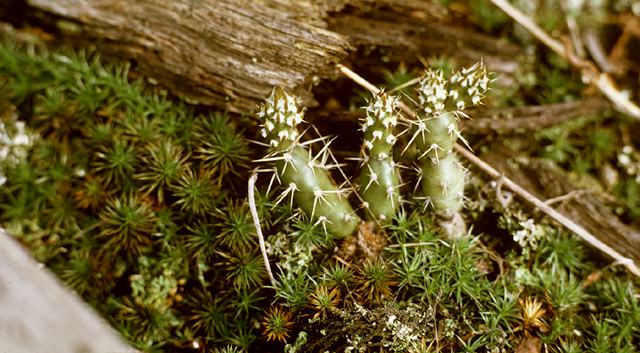

Fragile Prickly Pear Cactus
Opuntia fragilis (Nutt) Hawthorne
The fragile prickly pear cactus is the smallest and most cold-hardy species of prickly pear. The plant is a perennial that multiplies to form heaps or mounds up to three feet wide and a foot tall. Fragile prickly pear does not flower very often, but when conditions are right, there appear beautiful yellow blossoms nearly two inches across. The spiny, segmented stems of fragile prickly pear are unmistakable. These succulent pads are oblong to pear-shaped, and about one to two inches long. Several dozen spines up to an inch long decorate each pad. The scale-like true leaves are tiny and soon shed. Long, thick taproots penetrate deep underground. The fruits look like miniature dried figs. The pads are whitish green or dark green, up to about one inch wide. They may be somewhat flattened, especially the older joints , but often are cylindrical to oval. Undisturbed specimens can form large mats with hundreds of cladodes, with branches that are several-jointed, enabling the plant to spread widely. The younger joints break away from the parent plant and root very easily. The spines are brownish to grayish, usually with darker tips and are round or nearly round in cross-section. The spines tend to spread in all directions. The longest spines are often longer than the stem is wide. The fruit is green or reddish-green when immature, but becomes tan when mature. Plants have extremely shallow roots, which seldom penetrate below the top 10 cm. of soil. However, some plants have "long, thick taproots which penetrate deep underground. It grows in dry sand prairies and thin dry soil over rock outcrops. It is found at various scattered locations throughout the northwestern U.S.
Caution: The plant has numerous minutely barbed hairs that are easily dislodged when the plant is touched and they then become stuck to the skin where they are difficult to see and remove. They can cause considerable discomfort.
Food Uses
Leaf pads may used be cooked or raw. The outer skin is peeled off before
eating the pads. Fruits are sweet and gelatinous and used raw, cooked or dried for later
use. The unripe fruits can be added to soups etc, imparting an okra-like
mucilaginous quality. The fruit can hang on the plant all year round. The seed
is briefly roasted then ground into a powder. It is also used as a thickener.
Medicinal Uses
The flesh of the leaf pads is diuretic. A poultice of the flesh has been
used to treat skin sores and infections.
Planting
Requires a sandy or very well-drained soil. Plants must be kept fairly dry
in winter but they like a reasonable supply of water in the growing season. A
position at the base of a south-facing wall or somewhere that can be protected
from winter rain is best for this plant. Requires warmth and plenty of sun.
Plants tolerate considerable neglect. This species is fairly cold tolerant and
can succeed outdoors in a selected site in the milder areas of the country.
Cuttings of leaf pads at any time in the growing season. Remove a pad from the plant and then leave it in a dry sunny place for a couple of days to ensure that the base is thoroughly dry and has begun to callous. Pot up into a sandy compost. Very easy, rooting quickly. (PFAF)